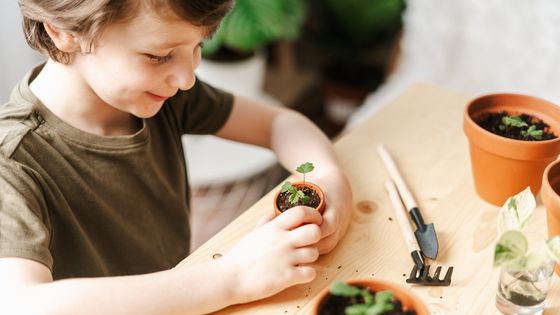Table of Contents:
- What do you need for the DIY Ceramic Plant Pot?
- Steps involved in making the DIY Ceramic Plant Pot:
- Wedge the clay and make a ball
- Give the basic shape of the pot
- Smooth down the pot
- Drying the pot
- Bisque firing
- Underglazing and glazing
- Glaze fire
- Which plants to grow in the DIY Ceramic Plant Pot?

Indoor plants undoubtedly add a beautiful ambience to your house. To make it even more lively and attractive, a variety of plant pots and containers are available in colors and designs to match the mood of your indoor décor. While you can choose any sort of pots and gardening accessories to decorate your little greens, making your own pot will give you a sense of warm connection with your plants. It creates a nice bond with the plant you grow in it, as you involve yourself in every step from making the pot to planting the plant and nurturing it. Here’s a guide to how to easily make your own ceramic plant pot. It’s really easy to do and also enables you to nurture your creative side.
What do you need for the DIY Ceramic Plant Pot?
Firstly, you need the materials for making the pot. Here’s the list:
- Wedged clay
- Water
- Potter’s wheel (only if you know how to use it otherwise you’ll use your fingers for shaping)
- Damp sponge
- Rib tool
- Wire and trimming tool for design (optional)
- Underglazes in different colors
- Clear glaze
- Newspaper
- Kiln for baking
You can choose to make a bunch of ceramic plant pots in a single batch if you want to make a collection or make assorted pots in one go. For the first time you can try making one pot and if you’re used to making pottery, then take a chance and make a number of plant pots at one go.
Steps involved in making the DIY Ceramic Plant Pot:
- Wedge the clay and make a ball: Take the amount of clay according to the size of the pot you are making. Make sure that you use wedged clay, i.e. clay from which air has been removed completely. Roll the clay into a ball.
- Give the basic shape of the pot: If you use a potter’s wheel, shape the clay into your desired form. Centre the clay on the wheel to produce a smooth surface. Use your index finger to push down the center and make the space inside the pot and also measure it to the base. A potter’s wheel will give a nicely shaped pot if you can use it properly. If you don’t know how to use a potter’s wheel, you can mold the clay to make a basic container first. Take the round ball of clay and push your thumb down its center to measure up to its base. Don’t push right through because you need to make the base of the pot. Widen the hollow and pinch across the edges to make the pot of uniform width. Keep the clay moist while working with it.
- Smooth down the pot: Use the damp sponge along with your fingers to smooth down the pot surface. Smoothing the ceramic plant pots at this stage ensures that it doesn’t crack. Smooth the outer edges, inside, and the bottom of the greenware. Use the rib tool for smoothing the outside of the pot to remove any lines if you use a potter’s wheel. If you think you’ll plant greens that would need a lot of watering, make sure to add drainage holes at the base. You can use the wire tool for designing the rim of the pot.
- Drying the pot: When you’re satisfied with the finish, let the pot dry. It needs to be dried for at least two hours.
- Bisque firing: Once the pot is bone dry you need to bisque fire the clay pot in the kiln for around 8 hours. At this stage all moisture is drawn out from the clay at very high temperatures, turning the clay into ceramic.
- Underglazing and glazing: After the pot is bisque fired and cooled down it is ready for the glazing process. Sometimes the underglaze can be done before the bisque fire. This enables to build up further underglazes after the bisque fire step. Use your choice of colors for underglazing the pot. Use as many coats as required. After underglazing, use the clear glaze for a smooth, shiny glossy finish that seals the clay surface. After glazing, wipe the base and set the pot on newspaper for drying for a few minutes.
- Glaze fire: Glaze fire the glazed pot in the kiln for another 8 hours. After this when the pot has cooled down, it is ready for potting.
Which plants to grow in the DIY Ceramic Plant Pot?
It’s best to start off with plants that don’t need too much water like small indoor cacti. Plants in ceramic pots dry up easily and overwatering can be harmful. However, glazed ceramics are better at holding moisture than terracotta planters. You need to check the soil texture regularly. You can add a layer of pebbles inside the pot before planting for healthy roots and shoots of the plant. Some varieties of fern plants like Boston fern and maidenhair fern are suitable for ceramic pots. Others like succulents, spider plants, and golden pothos are also suitable.
You’ll find the process of making your own ceramic plant pots oddly satisfying. They can also serve as cute little gifts to give to your dear ones. If you adore plant pots, baskets, and containers to dress up your indoor garden, you can also choose from readily available options.

















